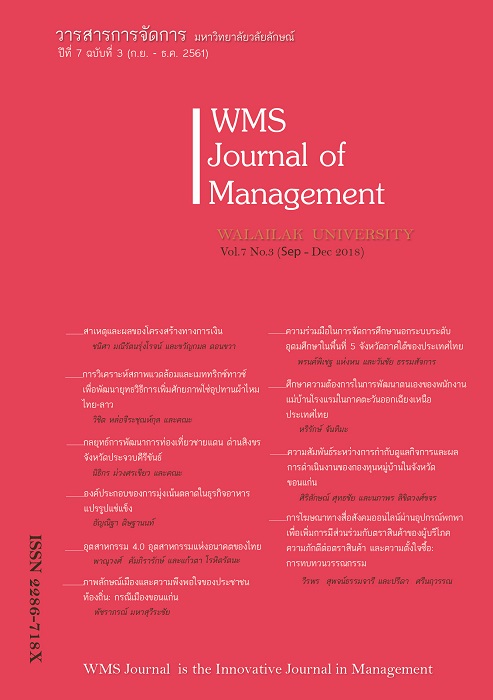Industry 4.0: Future Industries of Thailand
Main Article Content
Abstract
Industry 4.0 is the challenging and flagship policy to restructure the industrial sector of Thailand from labor intensive and basic technology in producing non-sophisticated and low value-added products and services to the industries driven by knowledge and advanced technologies, creativity and development as well as innovation in producing sophisticated and high value-added products and services. Industry 4.0 will result in higher income and higher economic growth that can make Thailand overcome the middle income trap. The research objective is to study and compare opportunities and potential of 10 target industries and to select the most highly potential 3 target industries. This qualitative research is based on analysis of secondary data and conduct of focus groups to collect additional primary data. Three highly potential industries include food for the future, biotechnology, as well as parts and spare parts, maintenance, repair and overhaul for aerospace. All of them can be regarded as future industries of Thailand.
Article Details
References
Working Group on Private Investment Promotion under the Ministry of Finance. (2015). Ten Target Industries: New Engine to Drive Economy for the Future. Retrieved November, 30, 2015. From http:// thaipublica.org/2015/11/kanis-boi/.
Paitoon Sinlarat. (2016). Education 4.0: More Than Education. (3rd Edition). Bangkok: Chulalongkorn University Press.
Office of The National Economic and Social Development Board. (2016). The 12th National Economic and Social Development Plan. Retrieved January, 12, 2017. From http://www. ratchakitcha. soc.go.th/DATA/PDF/2559/A/115/1.PDF.
Office of Industrial Economics. (2011). National Industrial Development Master Plan for 2012-2031. Retrieved October, 1, 2015. From http://www.oie.go.th/sites/default/ files/attachments/industry_plan/National_ Industrial_Development_Master_Plan.pdf.
National Innovation Agency. (2008). National Roadmap for the Development of Bioplastics Industry. Retrieved May, 1, 2016. From www.nia.or.th/bioplastics/ download/bioplast_roadmap.pdf.
National Innovation Agency. (2013). Thailand Science, Technology and Innovation Policy: A Platform for International Collaboration. Retrieved March, 1, 2016. From http://uswatch.mfa.go.th/ IRIND /5-KanchanaWanichkorn_Panel Discussion-Science%20Diplomacy%20and%20 International%20Research%20Netowork.pdf.
Matichon Newspaper. (28 July 2016). Goals of Permanent Secretary of Industry Somchai Harnhirun on Industry 4.0. Retrieved August, 30, 2016. From http://www. thaiauto.or.th/2012/th/news/news-detail.asp? news_id=3416.
Agenor, P. R., & Canuto, O. (2012). Middle-income growth traps. World Bank Policy Research Working Paper Series No. 6210. World Bank. Retrieved May, 10, 2016. From https://ssrn.com/abstract =2152800.
Cherif, R., & Hasanov, F. (2015). The leap of the tiger: How Malaysia can escape the middle income trap. IMF Working Paper WP/15/131. Retrieved May 10, 2016. From http://www.imf.org/external/pubs/ft/ wp/2015/ wp15131.pdf.
Eichengreen, B., Park, D., & Shin, K. (2011). When fast growing economies slow down: International evidence and implications for China. Asian Economic Papers, 11(1). 42-87.
Fortunato, P., & Razo, C. (2014). Export sophistication, growth and the middle-income trap. Transforming Economies: Making Industrial Policy Work for Growth, Jobs and Development. 267-287. Retrieved May, 12, 2016. From http:// mahdi.hashemitabar.com/cms/images/Download/transforming-economies.pdf.
Hausmann, R., Hwang, J., & Rodrik, D. (2007). What you export matters. Journal of Economic Growth, 12(1). 1-25.
Hill, H., Yean, T. S., & Zin, R. H. (2012). Malaysia: A success story stuck in the middle? World Economy, 35(12). 687-711.
Im, F. G., & Rosenblatt, D. (2013). Middle-income traps: A conceptual and empirical survey. World Bank Policy Research Working Paper Series No. 6594, World Bank.
International Service for the Acquisition of Agri-biotech Applications. (2015). Crop Biotech Update. Retrieved June, 2, 2016. From http://www.isaaa.org/Kc/cropbiotech update/default.asp.
Jitsuchon, S. (2012). Thailand in a middle-income trap. TDRI Quarterly Review, 27(2). 13-20.
Krugman, P. (2012). 14What happened to Asia7. Global Competition and Integration, 4. 315.
Mckinsey Global Institute. (2013). Disruptive technologies: Advances that will transform life, business, and the global economy. Retrieved June, 10, 2016. From www.mckinsey.com/mgi/overview.
Ohno, K. (2009). Avoiding the Middle Income Trap: Renovating Industrial Policy Formulation in Vietnam. ASEAN Economic Bulletin 26(1):25–43.
Popescu, R. F. & Bondoc, M.D. (2015). Selecting strategic industries: International practice. The Journal of Accounting and Management, 5(1).
Technology Strategy Board. (2012). High Value Manufacturing Strategy 2012 to 2015. Retrieved May, 10, 2016. From https:// www.gov.uk/government/publications/high-value-manufacturing-strategy-2012-to-2015.
The World Bank. (2014). The World Bank Annual Report 2014. Retrieved March, 10, 2016. From https://openknowledge.worldbank. org/ handle/10986/20093.
United Nations Industrial Development Organization. (2013). Industrial Development Report 2013: Sustaining employment growth: The role of manufacturing and structural change. Retrieved July, 10, 2016. From https:// www.unido.org/fileadmin/user_media/Research_and_Statistics/UNIDO_IDR_2013_main_report.pdf.
Warwick, K. (2013). Beyond Industrial Policy: Emerging Issues and New Trends. Retrieved December, 20, 2015. From https://www.coursehero.com/file/9813383/BEYOND-INDUSTRIAL-POLICY/.
Zhang, J. Weiss, J., & Lall, S. (2005). The sophistication of exports: A new measure of product characteristics. Asian Development Bank Institute. Retrieved March, 10, 2016. From https://think-asia.org/handle/11540/ 3611.

